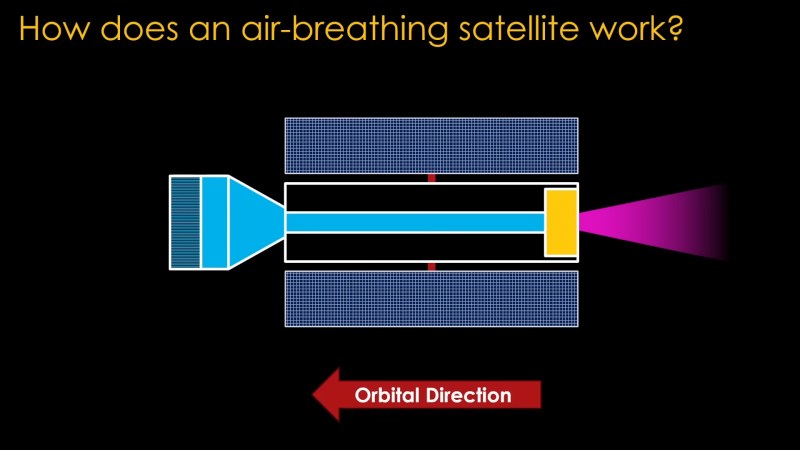The big problem with Low Earth Orbit is, oddly enough, air resistance. Sure, there’s not enough air to breathe in space, but there is enough to create drag when you’re whipping around the planet at 28,000 km/h (17,000 mph) or more. Over time, that adds up to a decaying orbit. [Eager Space] recently did a video summarizing a paradoxical solution: go even lower, and let the air work for you.
So called air-breathing satellites would hang out in very low earth orbit– still well above the Karman line, but below 300 km (186 miles)– where atmospheric drag is too dominant for the current “coast on momentum” satellite paradigm to work. There are advantages to going so low, chiefly for communications (less latency) and earth observation (higher resolutions). You just need to find a way to fight that drag and not crash within a couple of orbits.
It turns out this space isn’t totally empty (aside from the monoatomic oxygen) as missions have been at very low orbits using conventional, Xenon-fueled ion engines to counter drag. The xenon runs out pretty quick in this application, though, and those satellites all had fairly short lifetimes.
That’s where the air-breathing satellites come in. You don’t need a lot of thrust to stabilize against drag, after all, and the thin whisps of air at 200 km or 300 km above ground level should provide ample reaction mass for some kind of solar-electric ion engine. The devil is in the details, of course, and [Eager Space] spends 13 minutes discussing challenges (like corrosive monoatomic oxygen) and various proposals.
Whoever is developing these satellites, they could do worse than talk to [Jay Bowles], whose air-breathing ion thrusters have been featured here several times over the years.
















So how would the space/ground communications work on such a satellite, when the plasma produced by the atmospheric collision will effectively shield RF communications?
Maybe have antennas that poke through?
That high up you still won’t be generating much of a plasma sheath. Just not enough density yet.
If there is plasma, then the satellite has gotten way too low and is burning up.
Enough plasma to block RF communications is generated at much lower altitudes, about 60-70 Km of height.
The SpaceX satellites and other satellites operating for extended durations in very low orbits already deal with this.
Plasma, even during much more intense reentry does not automatically shield or block RF communications. Probably the most accessible demonstration of this is any SpaceX reentry video.
Previous systems, especially Apollo and the Space Shuttle, were dealing with different tradeoffs in band choice, antenna details, and power available. Plus “signal goes up” works WAY better during reentry than “signal goes down”.
A satellite’s space/ground communications don’t have to be single-hop. Relaying via a satellite in a higher orbit is a practical and very effective approach.
Maybe Jule’s wish is finally going to become true: Around the wold in 80 minutes. Right now we’re stuck at around 90 minutes, so well only have to shave of some 10 minutes.
This is not for shaving another millisecond off of Starlink ping times.. the interest in these is for putting weapons in orbit as part of the Golden Dome (missile defense system).
https://en.wikipedia.org/wiki/Golden_Dome_(missile_defense_system)
Frankly that’s the real money Elon’s been chasing. Good for engineers to keep in mind dual use before getting too excited. Same thing goes for space based solar power..
That’s just SDI warmed over. I don’t recall Brilliant Pebbles requiring stupidly low orbits, though I can see how it would be advantageous for them to hang out at low level.
Still, the link is pretty tenuous; all of the work [Eager Space] is talking about predates the announcement that Star Wars is back on the menu. For example, the ESA’s Gravity Field and Steady-State Ocean Circulation Explorer showed the scientific benefit of using an ion engine to hang out in Very Low Earth Orbit back in 2009.
The dual use capability is making it more exciting.
Also, more funding for fun toys. Because the dual-use goes BOTH ways.
The dual use aspect is making it more exciting.
That also means more funding for fun toys.
Because dual-use goes BOTH ways!
VLEO is bound to have many applications but you’re blatantly wrong currently – all operational VLEO satellites I know of are earth observers. You can take much better images from 250km than 650 km.
Why use ion thrusters? Couldn’t something like a propeller be used?
While there is enough atmosphere at the very-low-orbit level to cause noticeable drag, I suspect it’s too thin for propellers. IIRC, prop torque goes down with the square of air density, and the density is… very low. It might be better not to think of it as “air” in the aerodynamic sense, as just a bunch of molecules (and monoatomic oxygen) you’re running into.
Still, in this case an air-breathing ion thruster can be thought of as a bit like an electric ramjet.
“too thin for propellers”
At that level, is it thinner than the atmosphere on Mars? We do have some experience flying in rarified atmosphere that we can draw from.
Much thinner. Often better measured in gas-molecule impacts per minute, rather than torr or mm hg.
I wonder if a ramjet engine might work at that altitude.
GOGE was another low-rider…like the satellites at the beginning of Filmation’s FLASH GORDON
https://en.wikipedia.org/wiki/GOCE
PROFAC
https://en.wikipedia.org/wiki/Propulsive_fluid_accumulator